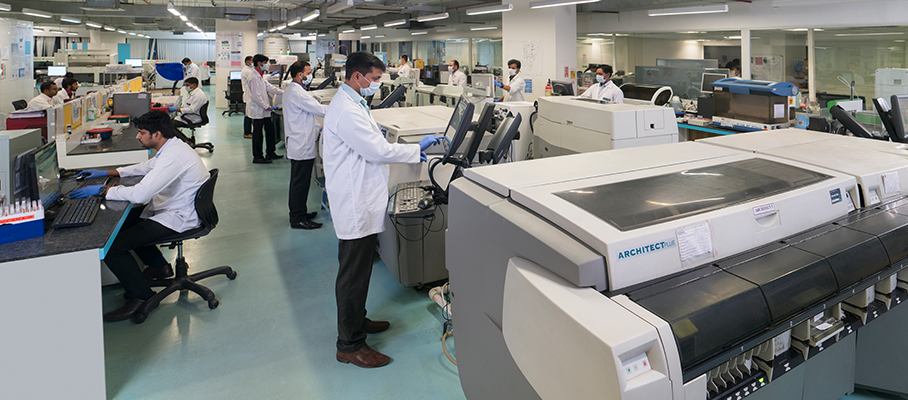Latest Blogs
Weight Loss Foods: Top 6 Food Choices to Boost Metabolism and Lose Inches
Every third person in the world is struggling with obesity as per some reports. Weight gain has emerged as a major lifestyle disease in the current times. Thanks to the unhealthily delicious junk food items available just a tap over the phone, almost nil physical activity levels and sleepless nights! Excessive weight isn't about just weighing a few more kilos, it is in fact a risk factor for a plethora of health problems including hypertension, diabetes, high cholesterol levels, etc. Being overweight can lead to musculoskeletal disorders also. Not just this, obesity has been identified as a factor that can increase your risk of developing severe COVID-19. Quick fact From 1975 to 2016, the prevalence of overweight or obese children and adolescents aged 5–19 years increased more than fourfold from 4% to 18% globally. Losing weight: The real struggle While most people understand the health risks associated with obesity, losing weight remains a big challenge. Do you know losing weight is one of the top new year resolutions every year? When it comes to weight loss, your diet plays a quintessential role. Many experts say weight loss is 30% exercise and 70% diet. Here we have enlisted top 6 food choices that can boost metabolism and help you lose inches: Top 6 foods that helps in weight loss High-protein foods: Foods that are high in protein such as lean meat, eggs, dairy, nuts, etc., can increase your metabolic rate for a few hours. This is because your body needs more energy to digest such food. This is called the Thermic effect of food. TEF refers to the use of calories during the digestion process. Research shows that protein-rich foods increase TEF the most. For example, they increase your metabolic rate by 15–30%, compared with 5–10% for carbs and 0–3% for fat (trusted source). The more protein you have in your body, the less you will feel hungry. Due to which you will be able to save yourself from overeating. Foods rich in iron and vitamin C: Iron-rich food is essential for the proper functioning of the thyroid gland, which helps regulate your metabolism. Research shows that eating foods that are lacking in iron can reduce the thyroid ability to produce enough hormones, which could slow down your metabolism. If you want your thyroid to function at its best, you should include foods that are rich in iron. Also, couple your iron intake with vitamin C. This helps enhance absorption of iron. Chili peppers: Chili pepper contains an element called capsaicin. These chemical increases metabolism in your body. This may help your body burn extra calories. A review of 20 research studies suggests that capsaicin supplements themselves can help your body burn about 50 extra calories per day. A research done on 200 people found that people who were consuming 2 mg of capsaicin before every meal burnt extra calories. Black coffee: The caffeine found in coffee can help in increasing our metabolic rate. Several studies have shown that people who consume at least 270 milligrams of caffeine daily, or the equivalent of about 3 cups of coffee, can burn up to an additional 100 calories per day. However, remember to consult your dietitian and do not overdo the caffeine intake as it can interfere with sleep and digestion. Quinoa: This can be rightly called as super grain when it comes to weight loss. It is packed with protein and fiber and contains approximately 220 calories per cup. Moreover, it provides various amino acids, which means it can be converted directly into muscle by the body. 6. Fruits and Nuts: Do you know anapple contains upward of 5 grams of fiber? Most fruits and nuts are rich in fibers and good fat. Hence, they are more filling compared to snacks of similar calorie amounts. You feel fuller, eat less junk throughout the day, and lose weight. What’s more? The fiber also helps keep the gut microbiome healthy and balanced. Having a healthy gut microbiome is an essential component of a good metabolism and maintaining a healthy weight. The Final and (most important) advice Besides taking care of your diet, make sure to drink enough water and keep yourself hydrated. Water helps you keep off extra calories by replacing the diet soda or fruit juice, both of which are full of sugar that can invite on the belly fat super fast. Maintain a good sleep schedule and ensure to get 7-8 hours of sound nap. Insomnia is notorious for causing weight gain issues in young adults. Make sure to get your health parameters checked from time to time as certain diseases like low thyroid levels can also cause you to gain weight. Book your health package here.
Young India under serious cardiac risk: Metropolis Healthcare
29 % population between 30 and 50 years have high plaque buildup in arteries Mumbai, September 20, 2015: Metropolis Healthcare Ltd, a multinational chain of pathology laboratories; has become one of the few laboratories in India to offer PLAC Test. 50% Heart attacks occurs in patients with normal cholesterol. Traditional markers of cardiovascular risk such as cholesterol levels tell physicians very little about acute risk of stroke or heart attack.The PLAC test is a US FDA approved, predictive test marker for cardiac risk stratification. Metropolis conducted a random pan India study on 311 samples of PLAC Testover a period of 20 months. Out of 311 samplesanalyzed, about 29% between the age group of 30 and 50 years were found to be at high risk of developing Coronary Heart Disease (CHD). PLAC is a simple blood test which can tell you how healthy your heart is and measures the enzyme activity of Lp-PLA2 level in the body. Lp-PLA2 is a cardiovascular specific inflammatory marker implicated in the formation of rupture prone plaque. This test helps in identifying hidden cardiac disease including heart attack and ischemic stroke. This PLAC test is highly recommended in four major guidelines ie AACE Guideline 2012, European Guideline 2012, AHA / ASA Guideline 2011, ACCF / AHA Guideline 2010. “Majority of heart attacks and strokes are caused by plaque ruptures. Basically plaques are made of fats, cholesterol found in blood. It is indeed natural that high cholesterol, especially high LDL can increase your chances of cardiovascular disease, hence cholesterol test wouldn’t suffice to predict your cardiac risk accurately. Surprisingly majority of heart attack occurs in people with normal cholesterol,” says Dr.SonaliKolte, General Manager – Medico Marketing, Metropolis Healthcare Ltd. If you all think that normal BP and Cholesterol levels under control, wouldn’t lead to cardiac risk then you are under serious misconception, she added. (Reference range – Low risk stratification: < 152 nm / ml, Medium risk stratification: 152 – 194 nm / ml, High risk stratification: > 195 nm / ml) Cardiac risk percentage wise An atherosclerotic plaque, also known as an atheroma, is a deposit of harmful fats, or lipids, on the blood vessel wall. When the plaque ruptures, globules resembling chunks of oatmeal break loose and suddenly clog a blood vessel, causing heart attack or stroke. Unhealthy life style that includes junk food, excess alcohol and smoking can increase the chance of stroke. Blood vessels become clogged with fatty deposits and make their way to the brain, hindering the oxygen supply. Who should undergo PLAC Test People with high blood pressure and high cholesterol Obesity People with heavy saturated fat intake Diabetes, alcoholic and chain smokers People with family history (Resource: AACE – American Association of Clinical Endocrinologist, AHA – American Heart Association, ASA – American Stroke Association, ACCF – American College of Cardiology Foundation)
7 out of every 10 Indians are Vitamin deficient: Metropolis Study
Pan India study of 14,96,683 samples reveals alarming statistics Metropolis Healthcare – a multinational chain of diagnostic centres conducted an inclusive study on Vitamin D, Vitamin B12 and Vitamin B9 (Folic Acid) to observe the deficiency and sufficiency of Vitamins within the inhabitants across India. Metropolis conducted a comprehensive pan India study on 14,96,683 samples over a period of 3 years. The increasing trend of Vitamin deficiency is seen in all the age groups. Among the samples tested across 4 zones viz, North, South, East, West 75% of population has shown alarming levels of deficiency. Commenting on the study Dr.SonaliKolte, General Manager, MedicoMarketing said, “Indians have a lethargic attitude towards Vitamins. Vitamin deficiencies usually develop slowly over several months to years Symptoms of Vitamin D deficiency are usually vague muscle/joint pain, weakness, bone pain, tiredness, fatigue or even depression. Nowadays it is observed that people who are deficient in Vitamin D are more likely to have diabetes, regardless of how much they weigh. Early diagnosis and treatment can help control the symptoms and prevent health related problems.” The Study In an analysis of over 14, 96,683 patients who underwent Vitamin tests, the following trends emerged. 81.28% of all samples tested were deficient in Vitamin D 21.02% of all samples tested were deficient in Vitamin B12 15.06% of all samples tested were deficient in Vitamin B9 Gender wise patterns emerged as below Age wise deficiency patterns emerged as below for the range of Vitamins Vitamin D: It has been a general belief that vitamin D deficiency is uncommon in India because of abundant sunshine. There is, however, now increasing evidence that this is not true. Vitamin D deficiency has reached epidemic proportions in India despite ample sunshine.Vitamin D is unique because it is a vitamin synthesized by the body and it functions as a hormone. Vitamin D is important for good overall health and strong and healthy bones. It’s also an important factor in making sure your muscles, heart, lungs and brain work well and that your body can fight infection. Your body can make its own vitamin D from sunlight. You can also get vitamin D from supplements and a very small amount comes from a few foods you eat. They are vital for everyone and ensure that your body works well and is able to fight illness and heal well. Vitamin D manages calcium in your blood, bones and gut and helps cells all over your body to communicate properly. Most common reason to have deficient levels of vitamin D due to limited sunshine exposure Studies suggest it may even help ease fibromyalgia pain and slow the progression of multiple sclerosis.It has also been linked to the various serious health conditions such as dementia, Alzheimer’s disease, prostate cancer, erectile dysfunction and mental disorder such as Schizophrenia Vitamin B12 regulates the functions of the brain and nervous system. It also plays an important role in the formation of blood.Some of the common symptoms of vitamin B12 deficiency are weakness, apathy, memory loss, acidity, loss of weight, nausea and vomiting, anemia, mental confusion, delusions, paranoia, respiratory symptoms, hives and other symptoms of allergy. A long-term deficiency can lead to heart attacks or stroke . The important sources of Vitamin B12 are mostly animal products like meat, fish, poultry, eggs and also dairy items. Pure vegetarian diet may result in Vitamin B12 deficiency which is becoming common amongst Indians.Vitamin B12 is also used to treat memory loss; Alzheimer’s disease; boosting mood, energy, concentration and the immune system; and slowing aging. Vitamin B12 also helps our bodies absorb folic acid, which facilitates the release of energy.The risk of B12 deficiency increases along with your age.Elderly people with low-vitamin B12 are more likely to suffer from brain shrinkage and cognitive decline. Vitamin B9, more commonly known as folate or folic acid, is a water-soluble vitamin that is part of the B vitamin family. Vitamin B9 (folic acid) is vital for several bodily functions, such as synthesis of DNA, RNA and to repairaiding rapid cell division and growth, to produce healthy red blood cells. It is important for pregnant women to have enough folic acid to prevent major birth defects of her baby’s brain or spine (neural tube defects, including spina bifida and anencephaly). It enhances brain health, folic acid supplementation may improve memory. Vitamins Deficiency is prevalent across India. Our pan India study also indicated that the majority of the study participants had limited knowledge, poor practices, and an ignorant attitude towards vitamin sufficiency. Clear messages are needed about risks and benefits of vitamins. If you’re unsure if you’re getting an adequate amount of vitamins, consult with your doctor.
The Metropolis Difference
Every sample has to undergo several steps before a reliable and an accurate report is produced. When you walk in to an accredited lab that adopts global practices, you will see that technology is intervened in every step; right from collecting the patient data to registering the sample and then the reports being auto-emailed through a meticulously built system. There are several things that could go wrong even before a sample is tested and hence it is important to adopt global practices to ensure that every report has the mark of a specialist and provide error free diagnosis. Our Central Laboratory is spread over 10,000 sqft area. All samples across the city are routed to the central laboratory for processing through a seamlessly working logistics team. Some samples also arrive from all over the country in case of specialised or super-specialised tests. A lab of International standards such as Metropolis will have a wide test menu. We have about 4500 tests and test combinations. We do many of the tests that are not available anywhere else in India or are generally outsourced. Samples are first categorised according to the department. For effective functioning, our central laboratory services has been segmented in to 7 core functions; Clinical Chemistry, Clinical Microbiology, Cytogenetics, Haematology, Molecular Diagnostics, Surgical Pathology and Research & Development. A rapid sample handling Pneumatic System designed on Lean Concept ensures that samples are sent to respective departments with no manual intervention. This significantly reduces the margin of error and ensures a superior TAT. Today technology is helping us perform better and faster thereby helping us make a difference to our customer’s health. For Ex: the Genexpert test that is based on DNA PCR accurately determines the presence of tuberculosis and also tells us if it is resistant to rifampicin. This is possible within 24 hours which used to take up to a week previously. Some of the technology that is in everyday use at such a laboratory are: ELISA, HPLC, Graphite Furnace Atomic Absorption Spectrometry, Fourier transform infrared spectroscopy, G Banding & Hi-resolution Banding, Karyotyping, Fluorescent in-situ hybridisation, Flow Cytometry, DNA sequencing, Real time PCR, Line Probe Assay, Liquid Based Cytology, Chromogenic In-situ hybridisation etc. Data mining technology has also helped us build a unique Indian Reference Range system for some tests. This results from our 3 decade experience in pathology. Such kind of innovations is possible only in a lab that adopts global practices and adheres to gold standards. Our CAP (College of American Pathologists) and NABL (National Accreditation Board for Calibration and testing) accreditations are proof to the work we do and the quality protocol that we rigorously adopt. Advancements in technology are taking diagnostics to newer heights. Today it is possible to personalise treatment based on diagnostic reports. At Metropolis, Innovations and investments in newer technologies and infrastructure is a given. As pathology specialists, we are well positioned to deliver the absolute best in the only thing we do: Revealing Inner Health.
Metropolis Healthcare reports Ovarian Cancer Data
Mumbai May 7, 2015: Ovarian cancer has emerged as one of the most common cancer affecting women in India. An analysis of samples collected over the past two years (2013-2014) by Metropolis Healthcare Ltd reveals that a total of 7945 tested positive for high CA125 levelsout of the 36,515samples processed at Metropolis Healthcare in Mumbai. According to Indian Journal of Cancer, 1 out of 5 women are prone to ovarian cancer. The majority of ovarian cancers arise from the epithelium (outer lining) of the ovary. 9 out of 10 ovarian cancers are epithelial ovarian cancers.A host of factors affects female ovaries such as family history, age, obesity, fertility drugs, personal history and hormone replacement therapy (HRT). Ovarian cancer is a highly aggressive cancer and is one of the leading causes of women’s death. It is an important cause of morbidity and mortality, especially in the middle aged women. Development of cancer cells in ovary accounts for about 4% per cent of all cancers in women.Certain inherited gene changes (mutations) can increase the risk of ovarian cancer. These include changes in the BRCA1 and BRCA2 genes. If you have inherited a mutation of one of these genes from either parent, your chances of getting breast and/or ovarian cancer increases. Ovarian cancer is difficult to pick up as symptoms like abdominal pain, persistent bloating and difficulty while eating are extremely common conditions in the disease.Accurate ways to detect ovarian cancer early could have a great impact on the cure rate. If a woman has these symptoms more than 12 times a month, she should see her doctor, preferably a gynecologist. Cancer Antigen – 125 test or popularly known as CA-125, assesses the concentration of this protein in the blood.Doctors may suggest a CA-125 test if they suspect ovarian cancer, endometrial, peritoneal or fallopian tube cancer. CA – 125 is a screening and monitoring test marker. However CA-125 has a low specificity & positive predictive value as it can be elevated in other cancers involving pancreas, breast, bladder, lung, and liver & in benign conditions like diverticulitis, endometriosis, pelvic tuberculosis, pleural effusion. Combining other detection methods like transvaginalsonography and rectovaginal pelvic examination increases the accuracy of detecting ovarian cancer. A CA-125 test result of greater than 35 U/ml is generally accepted as being elevated.CA125 test is one of the first tests doctor orders if he suspects early symptoms of Ovarian Cancer. In an analysis of data of over 2 years (2013-14), Metropolis Healthcare has analyzed the risk of ovarian cancer in Mumbai Of all the 7945 samples that tested abnormal, the following is the pattern of abnormality within age groups Commenting on the study, Dr.DeepakSanghavi, Deputy Chief of Lab Services, Metropolis Healthcare said “In ovarian cancer, cells in the ovary start to change and grow abnormally. If the cancer isn’t identified at an early stage, it can spread to the abdomen and pelvis, including other parts of the female reproductive system. Women who have their first full-term pregnancy after age 35 or who never carried a pregnancy to term have a higher risk of ovarian cancer.Breastfeeding may lower the risk even further. Fertility drugs with no outcome or hormone therapy after menopause is also linked to the disease. Mutations in BRCA1 and BRCA2 are also responsible for most inherited ovarian cancers.” Several advances in biomarker discovery and development have now led to additional tools that may be useful in the clinical management of women with adnexal masses, with recent FDA approval of Risk of Ovarian Malignancy Algorithm index popularly known as ROMA index gives a fair indication for the risk of ovarian cancer in pre- and post-menopausal women with a pelvic mass.The ROMA test is intended for use in women who meet the following criteria such as over 18 years of age, have an ovarian mass, surgery is planned or not yet referred to an oncologist (Source: Indian Journal of Cancer, American Cancer Society) *CA-125 (Reference range: All values between 0-35 U/ml is considered normal and values above 35 are out of the normal range. Clinical correlation is suggested
Metropolis announces launch of New Antibody Test for Major Kidney Disease
*Keeping pace with newer biomarkers in Autoimmunity- new antibody test launched for renal disease* 11th March 2015: One of the major kidney diseases, Nephrotic Syndrome is defined by massive continued loss of urinary proteins and edema (water retention). One of the major causes of Nephrotic Syndrome is Membranous Nephropathy or Membranous Glomerulonephritis which is a chronic inflammatory disease of the glomeruli (the network of capillaries in kidneys that perform the first step in filtering blood). In Membranous Nephropathy, an antibody-antigen complex otherwise called as the immune complex is formed in the glomerulus. This eventually leads to loss in kidney function and kidney failure. Membranous Nephropathy can be primary (where cause of the disease is not known; idiopathic) or could be secondary (as a result of an underlying condition like prolonged infection, tumor, cancer and even certain medications etc). It is important to differentiate primary and secondary since the treatment and disease management varies. In Primary Membranous Nephropathy, an individual undergoes an immunosuppressive therapy or kidney transplant), whereas in secondary, the underlying disease is treated. PLA2R Antibody Test is used to correctly differentiate the two kinds of disease, evaluate the intensity of the disease, monitor therapy and risk assessment after kidney transplant. Advantages of the test Serum based test and requires only a blood sample Easy to perform Presents a non-invasive alternative to the common biopsy. Anti-PLA2R autoantibodies are a highly specific and sensitive marker for primary MN. Additionally to its usage in differentiation of primary and secondary MN, the anti-PLA2R titer reveals a high predictive value for: Disease evaluation Anti-PLA2R autoantibody results correlate with disease activity (proteinuria). High titers are directly proportional with a severe course of primary MN. Therapy monitoring The anti-PLA2R autoantibody titer decreases in patients undergoing successful immunosuppressive therapy. A relapse of disease is associated with a recurrence of the antibodies. Furthermore, a high anti-PLA2R titer was identified as a considerable risk factor for primary MN patients to not achieve a remission of proteinuria. Risk assessment Up to 40 % of patients with primary MN experience a relapse after kidney transplantation. This risk is particularly high if anti-PLA2R autoantibodies are persistently found during the six months after organ transplantation. Therefore, the titer can be useful to assess the necessity and intensity of an immunosuppressive therapy after transplantation to avoid relapses. Commenting on the test, Dr Deepak Sanghavi who heads the Immunochemistry section at Metropolis Healthcare said “It is an important test that will help improve outcomes and disease management in such a chronic kidney disease. We have tied up with few hospitals and Institute of Kidney Diseases and offer this test at INR 4,500. Out of the suspected samples that we receive, almost 4 out of 10 returns positive”
Low Vitamin D levels – Significance beyond Bone Health: Metropolis Healthcare
Despite ample sunlight in India throughout the year, almost 80% of Indians are deficient in Vitamin D. Prolonged Vitamin D deficiency leads to a host of health issues. Recent studies link Vitamin D Deficiency with Diabetes, metabolic syndrome, blood pressure, heart disease, stroke and may even trigger symptoms of depression in a healthy population. There are various studies that directly correlate Vitamin D deficiency to PTH levels in the blood which is studied further in detail here. Vitamin D Deficiency& Parathyroid Hormone (PTH) Vitamin D deficiency, simply put is having low levels of Vitamin D in body, which causes the bones to become thin, porous and brittle.Vitamin D helps the intestines absorb calcium. Once activated, Vitamin D acts to greatly increase the amount of calcium that the intestines can absorb from food. For patients with vitamin D deficiency, it is difficult for the body to obtain calcium from the diet. This often leads to a rise in the PTH level, since the parathyroid glands must increase the PTH production, in order to increase calcium levels they absorb it from bones. Therefore, people with a normal blood calcium levels and a high PTH level may have secondary hyperparathyroidism, which means that the high PTH level is a normal response of healthy parathyroid glands to another problem (like vitamin D deficiency or kidney failure).The sole purpose of the parathyroid glands is to control calcium within the blood in a very tight range between 9.0 and 10.1. In doing so, parathyroid glands also control how much calcium is in the bones, and therefore, how strong and dense the bones are. Primary hyperparathyroidism Primary hyperparathyroidism most of the times results due to a non-cancerous tumor of the parathyroid, called an adenoma. Because of the adenoma, the parathyroid can make too much PTH, which can cause calcium to be too high in the blood, and overtime, lead to poor bone health. Sometimes doctors decide to treat primary hyperparathyroidism surgically, by removing the adenoma. If you have primary hyperparathyroidism, you need to work with your doctor to see if you can take vitamin D. Since you may have high blood calcium, it’s important to make sure you’re under a doctor’s supervision if considering taking vitamin D. Secondary hyperparathyroidism Secondary hyperparathyroidism is caused by either long term vitamin D deficiency or kidney failure. With long term vitamin D deficiency, the body may not get enough vitamin D to absorb adequate calcium. This can be corrected by treating vitamin D deficiency. It is important to note that accurate diagnosis is important to get to the core of the disorder and decide course and dosage of treatment accordingly. How does the Human body ensure that there is adequate amount of calcium in the blood? The human body can produce Vitamin D3 from direct exposure to sunlight. 7-dehydrocholestrerol is converted to Vitamin D3 with the help of UV Rays. However a large population of India does not face the sun as over 80% of the population is deficient in Vitamin D Poor/inefficient exposure to sunlight Sunscreen, full sleeved clothes acts as an impediment Dark colored skin requires longer exposure to sunlight Poor dietary /supplementary intake When you get enough vitamin D from good sun exposure and supplementation habits and enough calcium from your diet, this allows you to maintain a healthy calcium level in your blood and keep good amounts of calcium in your bones. Healthy vitamin D and calcium habits also help keep your PTH levels in check. Prolonged Vitamin D Insufficiency or Deficiency leads to reflex increase in PTH levels in the blood. This is called secondary Hyperparathyroidism, in which PTH mobilizes bone calcium which leads to increased bone fragility and risk of fractures or increased level of calcium in blood. Secondary Hyperparathyroidism is commonly the result of compensatory over secretion of PTH in response to Vitamin D deficiency. In a recent study done by the R&D team at Metropolis Healthcare, the following are the study results. According to R&D team in Metropolis Healthcare, when the calcium level in the blood drops, due to Vitamin D deficiency, high levels of Parathyroid Hormone (PTH) are secreted by the parathyroid gland, which absorbs calcium from bones, leading it to become brittle and porous. How it affects the people? Many people with Vitamin D deficiency can have increased levels of Parathyroid Hormone (PTH) in the body. The main function of PTH is to maintain calcium levels in the blood stream. With the decrease in Vitamin D levels, there will be drop in the calcium levels, in order to balance the calcium level in the blood, parathyroid gland starts secreting high levels of parathyroid hormone. PTH starts to absorb calcium from bone replenishing the calcium level in the blood, which in turns leads to weakening of bones, making it more fragile or prone to fractures. The Study In an analysis of over 7,542 patients who underwent both Vitamin D and PTH tests, the following trends emerged. An increasing trend can be witnessed from 30 to 40 age group and above, indicating an increasing level of susceptibility with progression in age Observations: Elevated PTH levels were found in the age group of 20 – 50 years contributing to 24.11%. Such patients are at a high risk of developing High BP, Diabetes, Heart diseases. Of these deficient samples 28.98% were of women.Vitamin D deficiency with PTH elevation can have several ill effects on bone and increased risk of high BP, Diabetes & Heart disease.
 Home Visit
Home Visit Upload
Upload




















 WhatsApp
WhatsApp